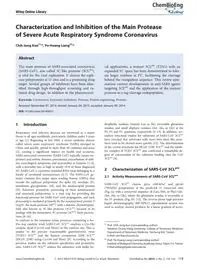
2015 Characterization and Inhibition of the Main Protease of Severe Acute Respiratory Syndrome Coronavirus PDF
Preview 2015 Characterization and Inhibition of the Main Protease of Severe Acute Respiratory Syndrome Coronavirus
Characterization and Inhibition of the Main Protease of Severe Acute Respiratory Syndrome Coronavirus Chih-Jung Kuo[1],*, Po-Huang Liang[2],* www.ChemBioEngRev.de ª 2015 WILEY-VCH Verlag GmbH & Co. KGaA, Weinheim ChemBioEng Rev 2015, 2, No. 2, 118–132 118 Abstract The main protease of SARS-associated coronavirus (SARS-CoV), also called 3C-like protease (3CLpro), is vital for the viral replication. It cleaves the repli- case polyproteins at 11 sites and is a promising drug target. Several groups of inhibitors have been iden- tified through high-throughput screening and ra- tional drug design. In addition to the pharmaceuti- cal applications, a mutant 3CLpro (T25G) with an expanded S1¢ space has been demonstrated to toler- ate larger residues at P1¢, facilitating the cleavage behind the recognition sequence. This review sum- marizes current developments in anti-SARS agents targeting 3CLpro and the application of the mutant protease as a tag-cleavage endopeptidase. Keywords: Coronavirus, Enzymatic hydrolysis, Protease, Protein engineering, Proteins Received: November 07, 2014; revised: January 04, 2015; accepted: January 09, 2014 DOI: 10.1002/cben.201400031 1 Introduction Respiratory viral infective diseases are renowned as a major threat to all ages worldwide, particularly children under 5 years of age [1]. Beginning in late 2002, a severe epidemic disease called severe acute respiratory syndrome (SARS) emerged in China and quickly spread to more than 30 countries and areas [2], causing a significant impact on health and economy. SARS-associated coronavirus (SARS-CoV) typically causes res- piratory and enteric diseases, pneumonia, exacerbation of asth- ma, neurological symptoms, and myocarditis in humans [3–5], with a mortality rate as high as nearly 10 % of those diagnosed [6]. SARS-CoV is a positive-stranded RNA virus belonging to a family of enveloped coronaviruses [5, 7]. The SARS-CoV ge- nome contains five major open reading frames (ORFs) that encode the replicase polyprotein, the spike (S), envelope (E), membrane glycoproteins (M), and the nucleocapsid protein (N). Extensive proteolytic processing of these nonstructural and structural polyproteins is a vital step for providing the functional proteins for SARS-CoV viral propagation, and such processing is mediated primarily by the nonstructural protein 5 (nsp5), the main protease (Mpro) with a dimeric chymotrypsin- fold, also known as 3C-like protease (3CLpro) because of its analogy with the monomeric 3C protease (3Cpro) form picorna- virus [8–10]. In contrast to the common serine proteases containing a Ser- His-Asp catalytic triad, SARS-CoV 3CLpro employs a Cys-His catalytic dyad (Cys145 and His41) in the catalytic site. This is similar to the porcine transmissible gastroenteritis virus (TGEV) 3CLpro and the human coronavirus 229E 3CLpro (HCoV 229E) using Cys144 and His41 [8]. According to the previous studies on the substrate specificities and proteolytic sites, SARS-CoV 3CLpro utilizes the substrates with bulky hy- drophobic residues (mainly Leu or Ile), invariable glutamine residue, and small aliphatic residues (Ser, Ala, or Gly) at the P2, P1 and P1¢ positions, respectively [8–13]. In addition, sec- ondary structural studies for substrates of SARS-CoV 3CLpro have revealed that substrates with more beta-sheet like struc- tures tend to be cleaved more quickly [12]. The determination of the crystal structures for HCoV 229E 3CLpro and the inhibi- tor complex of TGEV 3CLpro also confirmed a remarkable de- gree of conservation of the substrate binding sites for CoV 3CLpro [8]. 2 Characterization of SARS-CoV 3CLpro 2.1 Activity Measurements of SARS-CoV 3CLpro SARS-CoV 3CLpro cleaves pp1a (486 kDa) and pp1ab (790 kDa) polyproteins at the predicted 11 conserved sites (Fig. 1a) with a conserved sequence of (Leu, Met, or Phe)-Gln- (Ser, Ala, or Gly), where the glutamine residue is invariable at the P1 position (Fig. 1b) [12]. The reverse-phase high-pressure liquid chromatography (RP-HPLC) experimental system was used to analyze cleaved products by a linear gradient of aceto- ————— [1] Prof. Chih-Jung Kuo (corresponding author) National Chung Hsing University, College of Veterinary Medicine, Department of Veterinary Medicine, Taichung 402, Taiwan. E-Mail:
